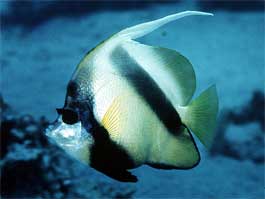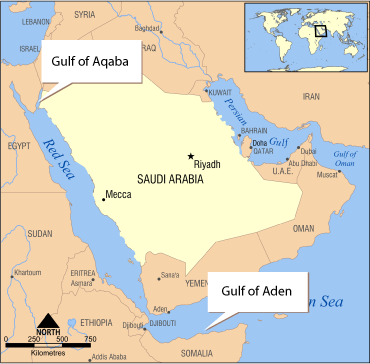You are here: Home › Stressors › Invasive Species › NOAA/NCCOS Invasive Species Bulletin: Red Sea Bannerfish

NOAA/NCCOS Invasive Species Bulletin
Red Sea Bannerfish
The Red Sea Bannerfish, Heniochus intermedius Steindachner 1893, has been photographed living on Paul's Reef, which is about seven miles south of the Palm Beach Inlet, near Palm Beach, Florida. Only one individual was identified, in about fifty feet of water.
Biogeography:

The Red Sea Bannerfish is known to occur naturally in the Red Sea, Gulf of Aqaba and Gulf of Aden. It has been reported as a recent introduction in low numbers in the Mediterranean Sea — Gulf of Antalya, Turkey (2002) and in the Adriatic Sea (2004), and now in the Atlantic off Florida (2006). There is no evidence of breeding at these sites of introduction. Depths range from 3 to 50 meters.
Route of Introduction:
The Red Sea Bannerfish is a common aquarium species sold in Florida and elsewhere. Due to the discovery of several exotic saltwater aquarium fish species living on reefs in the same area off Florida, it is likely that this fish and other exotic tropical fishes showing up in Florida are aquarium-related releases. Studies comparing ballast water release and aquarium release in Florida (Semmens et al. 2004) support the hypothesis that the aquarium trade is the pathway for introduction of this species.
Biology:
The Red Sea Bannerfish usually is seen living on coral slopes, in pairs as adults. Members of this species also can be found singly or in larger groups. Up to 24 individuals have been reported schooling off Eritrea. They seem to occupy home ranges but are not territorially aggressive. Juveniles are found primarily at the base of reefs, living in larger groups. In the Red Sea, these fish feed most actively at sunset and during the night. Thus divers may be less likely to see many Bannerfish in the daytime, as the fish may be hiding among corals during the day.
The Bannerfish reproduces by spawning eggs and sperm; development is planktonic. Little is known about development time or any migratory patterns during the larval phase. FishBase reports preliminary data that the doubling time for a population of Red Sea Bannerfish is 15 months.
The Red Sea Bannerfish appears to be a generalist feeder. It has been reported as a benthic feeder eating mostly sedentary polychaetes and some corals and other invertebrates off Eritrea, but as a planktonic feeder on larvaceans in the Gulf of Aqaba. It has a short gut, indicating that it doesn't eat as much algae and corals as some other butterfly fish species, but it is likely that it consumes some algae.
It would be interesting if the Gulf of Aqaba population was, on closer genetic inspection, a different species from the Red Sea species. But a more mundane explanation is that this generalist species can switch prey depending on availability, and participates in resource partitioning with other similar fishes depending upon the local fish assemblage.
Risk Assessment:
The fact that the Red Sea Bannerfish is a highly successful aquarium fish means that is a good survivor and hence it poses a danger as an invasive species in coral reef habitats where it is not native. Differences in diet at different locations within the natural range of the fish suggest a plasticity in diet that could allow the fish to survive and breed in new locations. On the other hand, such plasticity may be an evolutionary compensation for low aggression in competitive interactions with other reef species. This species is neither aggressive with other fish nor harmful to humans. The fish’s diet does not center on organisms such as corals and coralline algae that form reef structure.
The Red Sea Bannerfish is not restricted to areas containing particular coral species, as are some other butterfly fish. Massive schools of Bannerfish are not likely, based upon observed behavior in its natural habitat. However, this species is dependent upon coral cover in the Red Sea for hiding during the day, and populations could be larger than detected because of cryptic daytime behavior when most divers observe them.
On the basis of very limited information, we tentatively conclude that the level of risk for successful introduction of the Red Sea Bannerfish in tropical reef habitat is high, but the level of risk for damage to structural elements of its new habitat or human economic interests is relatively low compared with fish such as the Lionfish. Risk for altering the ecological balance of invaded ecosystems is unknown, and requires further observation and research.
Action:
NOAA encourages individuals to report sightings of the Red Sea Bannerfish, or any other fish that appears to be an exotic species. Also visit the Nonindiginous Aquatic Species (NAS) Alert System, provided by the US Geological Service (USGS). You can enter new sightings on their site, too. This website is monitored by the National Oceanic and Atmospheric Administration’s NCCOS, which reviews Marine and Great Lakes alerts and develops bulletins and risk assessments for managers.
For Further Information:
Web Pages:
Hard Copy Publications:
Allen G.R., R. Steene and M. Allen, 1998. A Guide to Angelfishes and Butterflyfishes. Perth : Odyssey Publishing/Tropical Reef Research. 250 p.
Fenner, Bob. 1990. Bannerfish butterflies, the genus Heniochus . FAMA 6/90.
Gökoglu M., T. Bodur and Y. Kaya, 2003. First record of the Red Sea bannerfish ( Heniochus intermedius Steindachner, 1893) from the Mediterranean Sea . Israel Journal of Zoology , 49: 324-325.
Goldstein, Robert J. 1977. Angels and butterflies– Indian Ocean and Red Sea . Marine Aquarist 8:2, 77.
Randall J.E., 1983. Red Sea Reef Fishes. IMMEL Publishing, London . 192 pp.
Semmens, B.X., E.R. Buhle, A.K. Salomon, and C.V. Pattengill–Semmens. 2004. Tankers or fish tanks: what brought non–native marine fishes to Florida waters. Marine Ecology Progress Series. 266:239-244.



